Experimental Study on the Shear Behavior of Precast Wall Concrete Joints with/without Dowel Reinforcement
Abstract
:1. Introduction
1.1. General
1.2. Research Significance
2. Experimental Program
2.1. Description of Test Specimens
2.2. The Construction Process of Test Specimens
2.3. The Setup and Test Procedure
3. Experimental Results and Discussion
3.1. Damage Process and Mode
3.2. Normalized Average Shear Stress and Relative Displacement
4. Shear Capacity of the Joints
4.1. Shear Strength of Dry Keyed Joints
4.2. Shear Strength of Epoxied Joints and Joints with Dowel Reinforcement
5. Conclusions
Author Contributions
Funding
Acknowledgments
Conflicts of Interest
References
- Zhi, Q.; Guo, Z.X.; Xiao, Q.D. Quasi-static test and strut-and-tie modeling of precast concrete shear walls with grouted lap-spliced connections. Constr. Build Mater. 2017, 150, 190–203. [Google Scholar] [CrossRef]
- Zhi, Q.; Zhou, B.B.; Zhu, Z.F. Evaluation of load–deformation behavior of reinforced concrete shear walls with continuous or lap-spliced bars in plastic hinge zone. Adv. Struct. Eng. 2019, 22, 722–736. [Google Scholar] [CrossRef]
- Zhou, X.; Mickleborough, N.; Li, Z. Shear Strength of Joints in Precast Concrete Segmental Bridges. ACI Struct. J. 2005, 102, 901–903. [Google Scholar]
- Jiang, H.; Chen, L.; Ma, Z.J. Shear behavior of dry joints with castellated keys in precast concrete segmental bridges. J. Bridge Eng. 2015, 20, 04014062. [Google Scholar] [CrossRef]
- Jiang, H.; Wei, R.; John, M.Z. Shear strength of steel fiber-reinforced concrete dry joints in precast segmental Bridges. J. Bridge Eng. 2016, 04016085. [Google Scholar] [CrossRef]
- American Association of State Highway and Transportation Officials (AASHTO). LRFD Bridge Design Specifications; AASHTO: Washington, DC, USA, 2010. [Google Scholar]
- ACI (American Concrete Institute). ACI318-14: Building Code Requirements for Structural Concrete; American Concrete Institute: Farmington Hills, MI, USA, 2014. [Google Scholar]
- JGJ 1-2014, Technical Specification for Precast Concrete Structures; Chinese code: Beijing, China, 2014. (In Chinese)
- Turmo, J.; Ramos, G.; Aparicio, A.C. Shear strength of dry joints of concrete panels with and without steel fibres: Application to precast segmental bridges. Eng. Struct. 2006, 28, 23–33. [Google Scholar] [CrossRef]
- Issa, M.A.; Abdalla, H.A. Structural behavior of single key Joints in precast concrete segmental bridges. J. Bridge Eng. 2007, 12, 315–324. [Google Scholar] [CrossRef]
- Jiang, H.; Feng, J.; Liu, A. Effect of specimen thickness and coarse aggregate size on shear strength of single-keyed dry joints in precast concrete segmental bridges. Struc. Concr. 2019, 20, 955–970. [Google Scholar] [CrossRef]
- Farina, I.; Modano, M.; Zuccaro, G. Improving flexural strength and toughness of geopolymer mortars through additively manufactured metallic rebars. Compos. Part B: Eng. 2018, 145, 155–161. [Google Scholar] [CrossRef]
- Jahanmohammadi, A.; Soltani, M. Toward combined local-average stress field modeling of reinforced concrete. Eng. Struct. 2016, 111, 394–410. [Google Scholar] [CrossRef]
- Walraven, J.C.; Reinhardt, H.W. Theory and experiments on the mechanical behavior of cracks in plain and reinforced concrete subjected to shear loading. Heron 1981, 26, 1–68. [Google Scholar]
- Rombach, G.A.; Specker, A. Segmentbrücken. Beton-Kalender, Teil 1; Verlag Ernst und Sohn: Berlin, Germany, 2004; pp. 177–211. (In German) [Google Scholar]
- Mattock, A.H.; Hawkins, N.M. Shear Transfer in Reinforced Concrete—Recent Research. PCI J. 1972, 17, 55–75. [Google Scholar] [CrossRef]
- GB/T 50081-2002, Standard Test Method for Mechanical Properties of Normal Concrete; Chinese Code: Beijing, China, 2002. (In Chinese)
- PTI (Post-Tensioning Institute). Precast Segmental Box Girder Manual; PCI (Prestressed Concrete Institute): Phoenix, AZ, USA, 1978. [Google Scholar]
- PCI (Prestressed Concrete Institute). PCI Design Handbook: Precast and Prestressed Concrete, 8th ed.; PCI (Prestressed Concrete Institute): Phoenix, AZ, USA, 2004. [Google Scholar]
- Buyukozturk, O.; Bakhoum, M.M.; Beattie, S.M. Shear Behavior of Joints in Precast Concrete Segmental Bridges. J. Struct. Eng. ASCE 1990, 116, 3380–3401. [Google Scholar] [CrossRef]
- Gaston, J.R.; Kriz, L.G. Connections in precast concrete structures. PCI J. 1964, 9, 37–59. [Google Scholar] [CrossRef]
- Tassios, T.; Vintzeleon, E. Concrete-to-concrete friction-closure. J. Struct. Eng. ASCE 1988, 113, 832–849. [Google Scholar] [CrossRef]

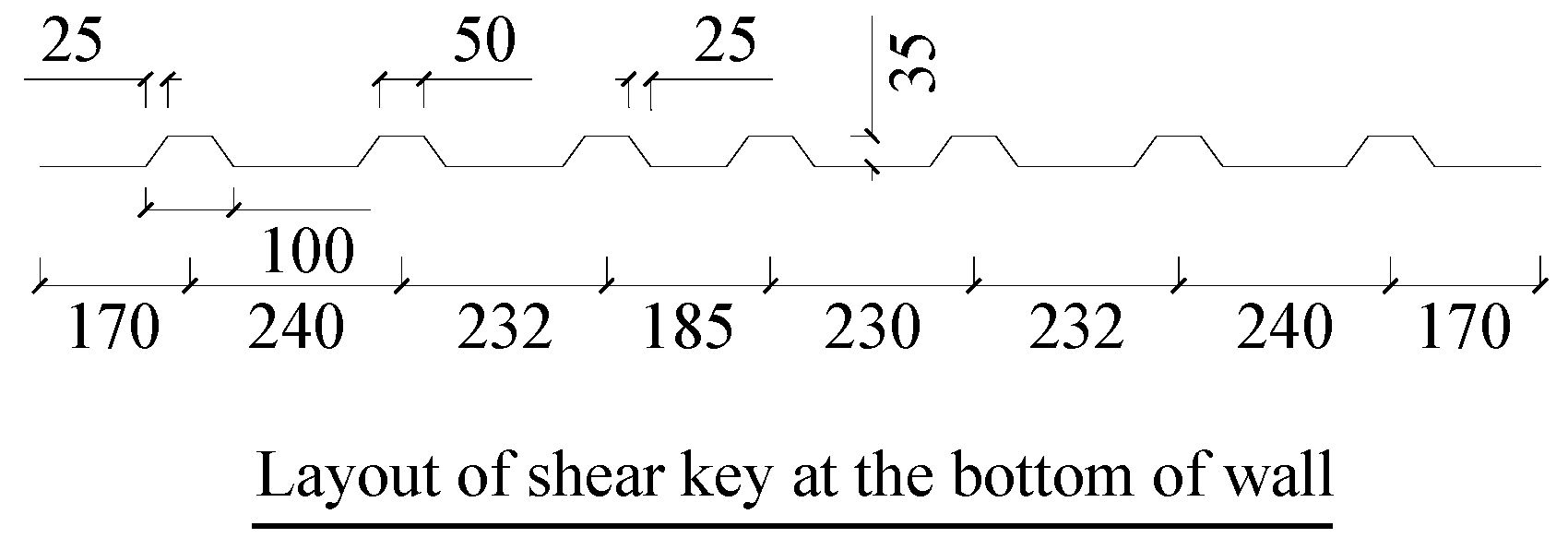
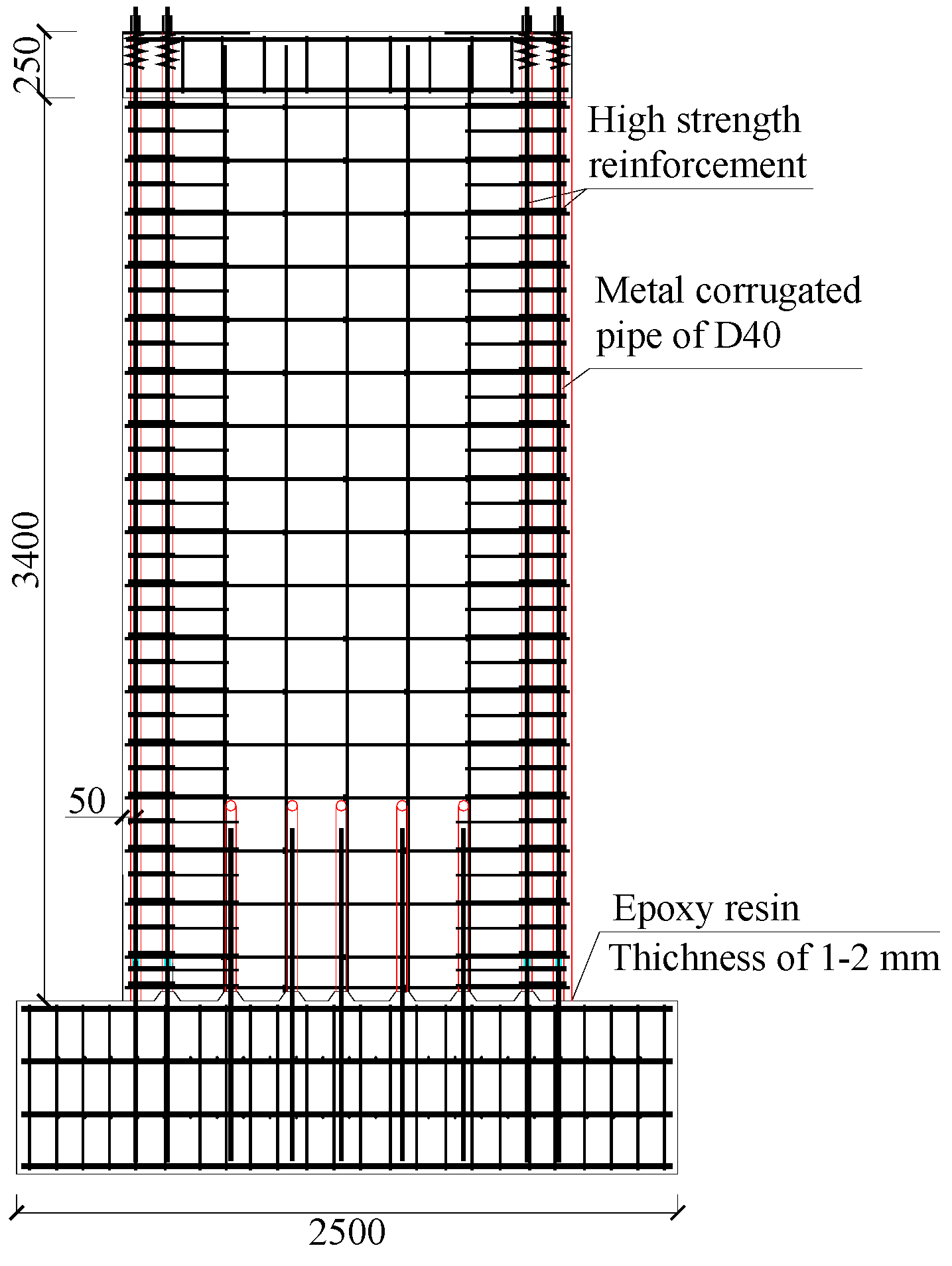



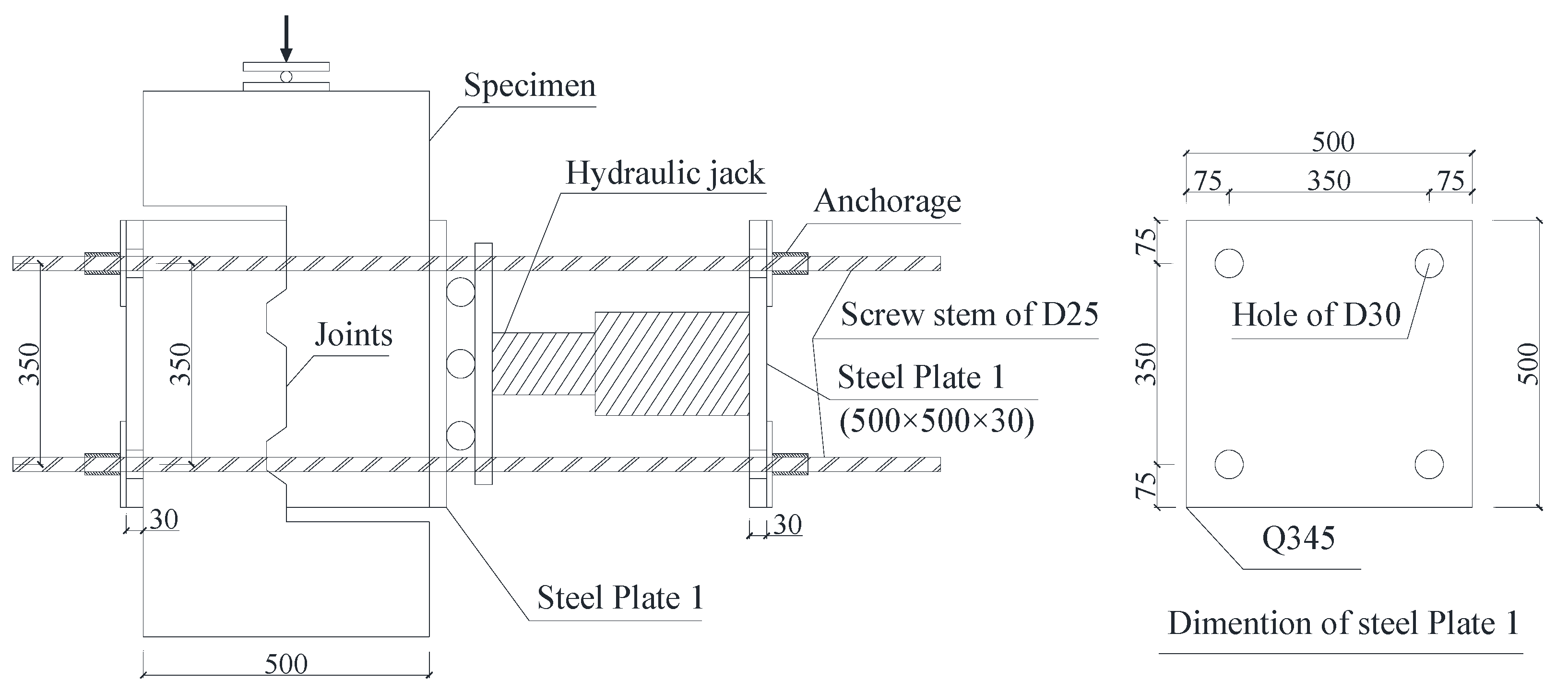
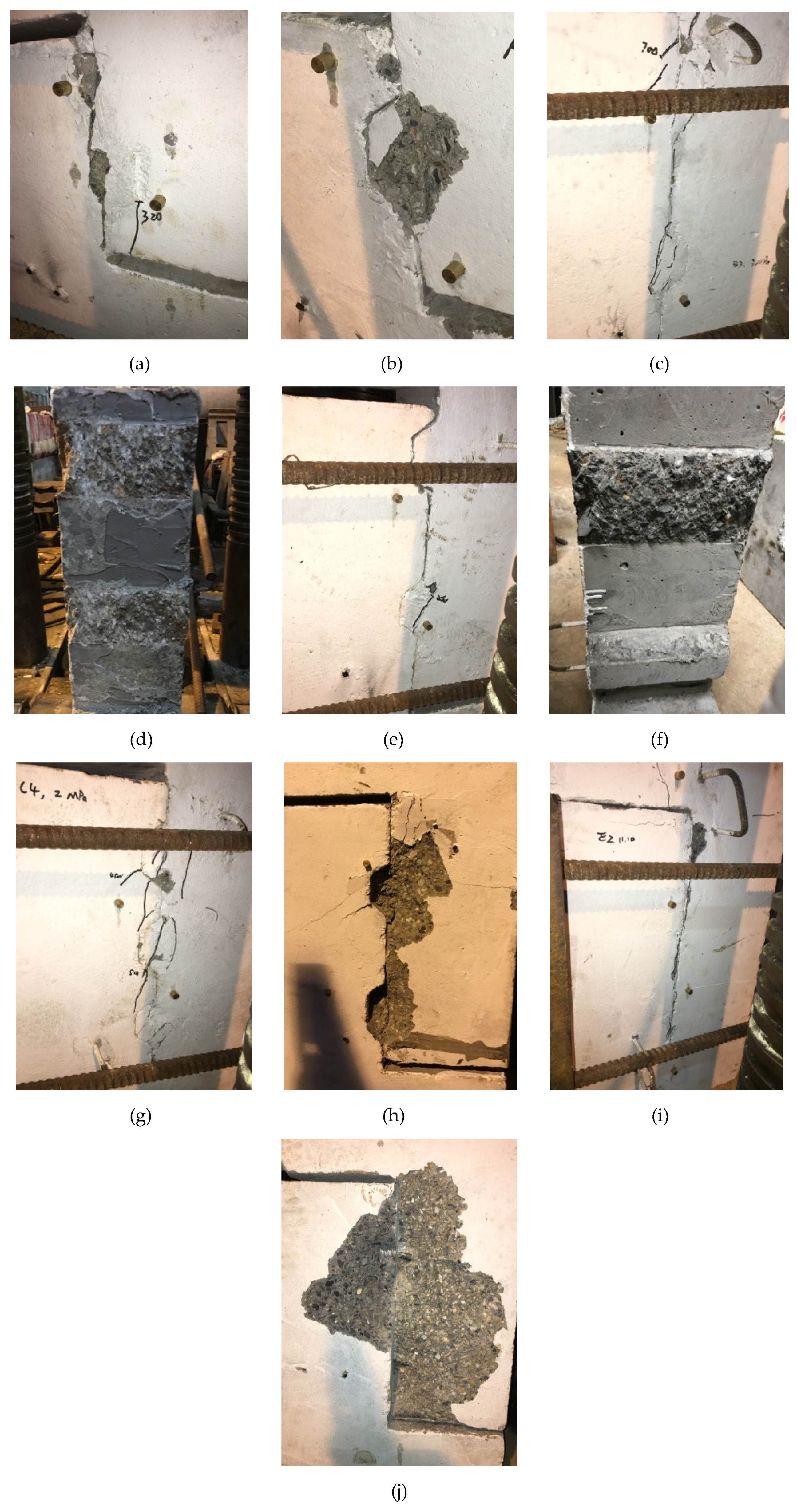
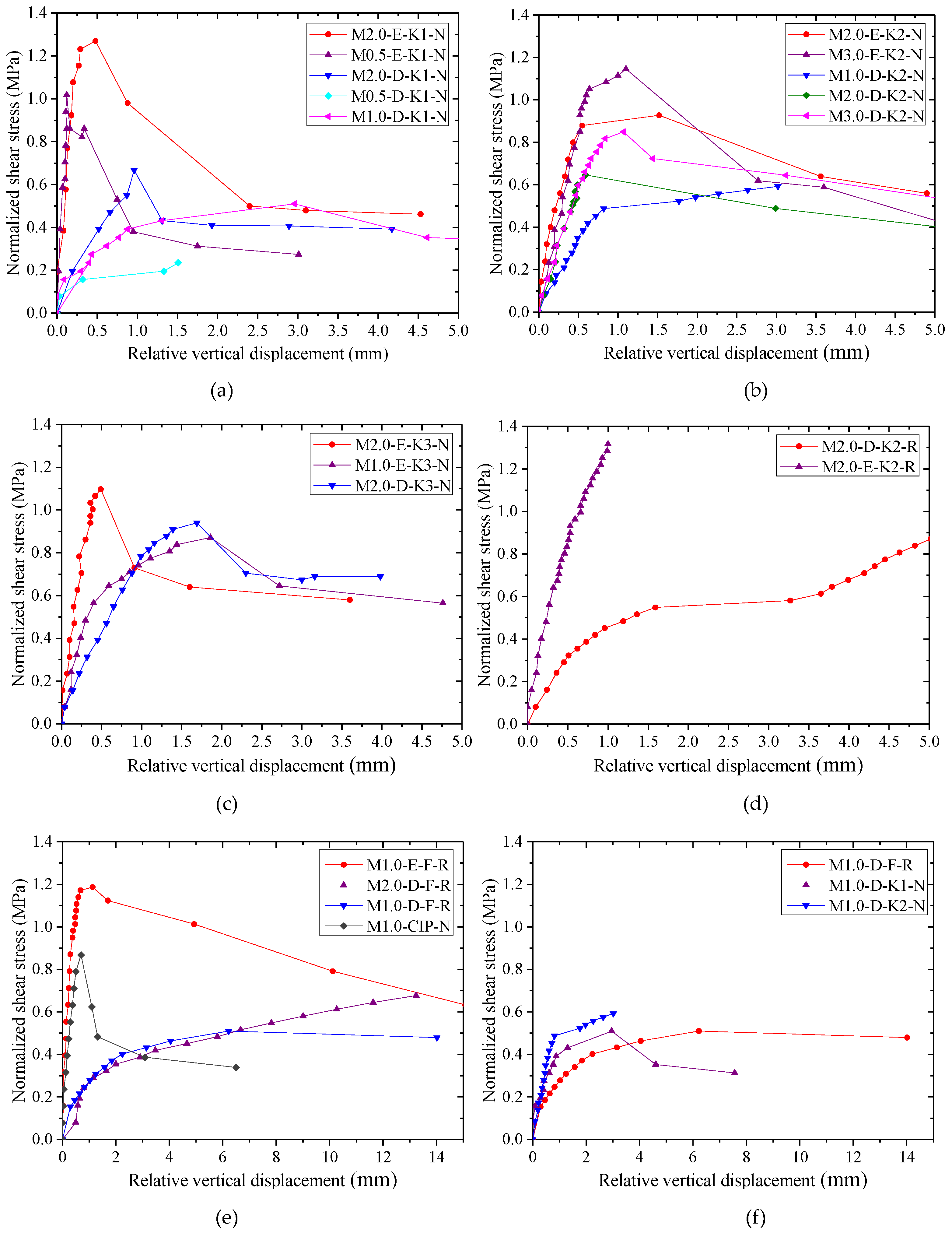


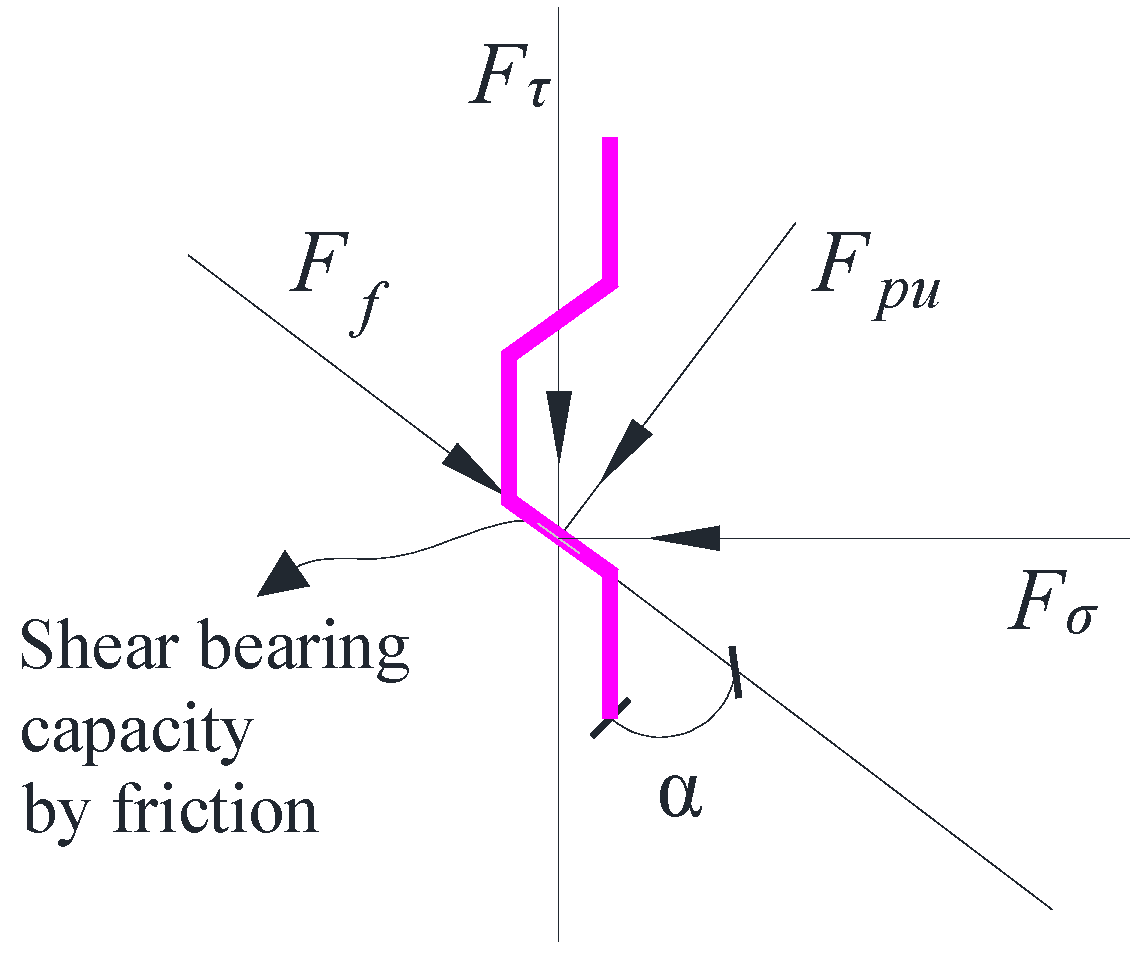
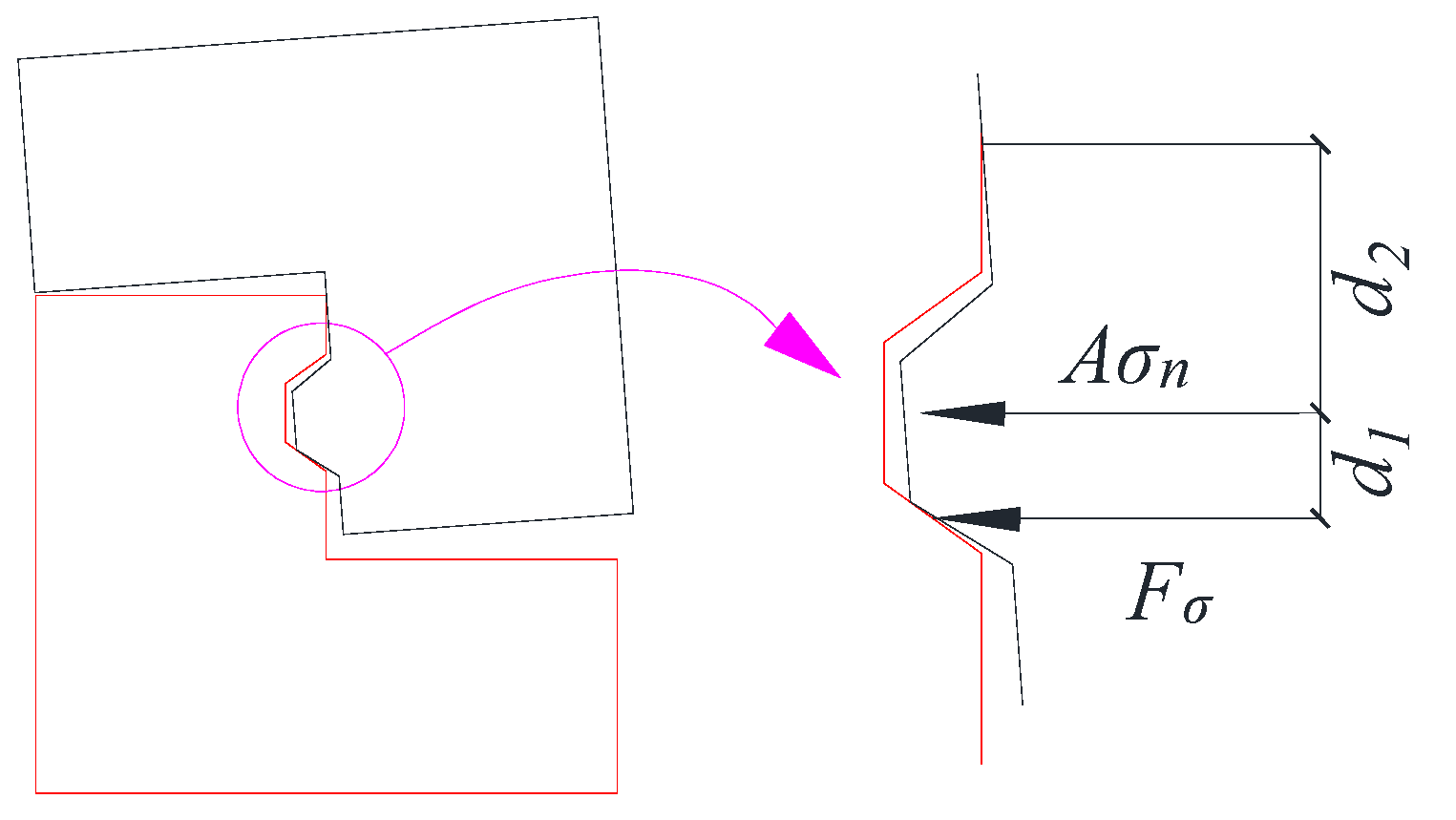
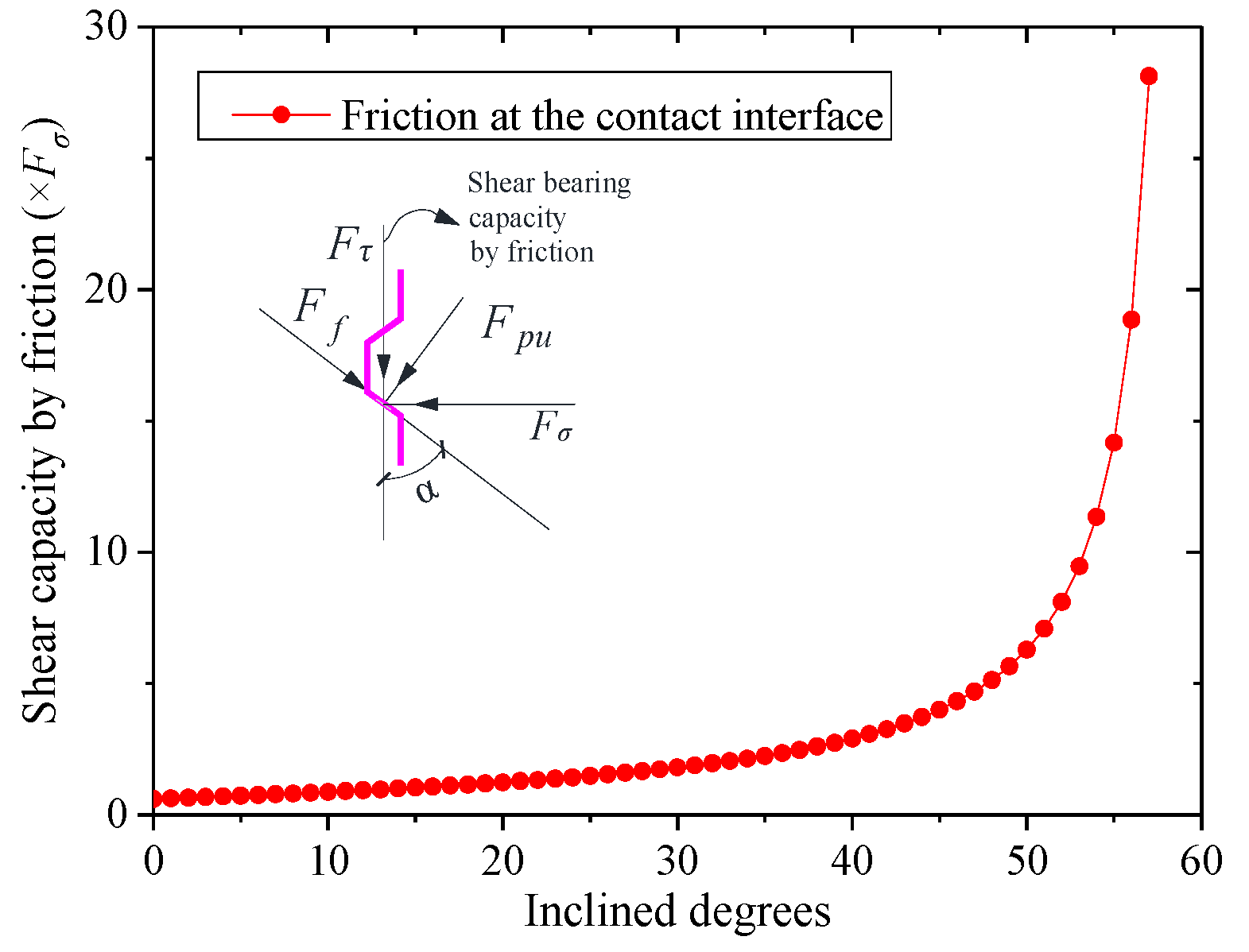

| No. | Specimen | Concrete Strength (MPa) | Number of Keys | Confining Stress (MPa) | Dry or Epoxy Resin | Contacted State of the Interface | |
|---|---|---|---|---|---|---|---|
| Left Component | Right Component | ||||||
| A1 | M2.0-E-K1-N | 37.8 | 42.2 | 1 | 2.0 | Epoxy resin | Complete |
| A2 | M0.5-E-K1-N | 40.2 | 40.8 | 1 | 0.5 | Epoxy resin | Complete |
| A3 | M2.0-D-K1-N | 38.1 | 40.6 | 1 | 2.0 | Dry | Complete |
| A4 | M0.5-D-K1-N | 41.3 | 40.6 | 1 | 0.5 | Dry | Partial |
| A5 | M1.0-D-K1-N | 41.3 | 40.6 | 1 | 1.0 | Dry | Partial |
| B1 | M2.0-E-K2-N | 39.6 | 39.1 | 2 | 2.0 | Epoxy resin | Complete |
| * B2 | M2.0-E-K2-N | 38.9 | 34.7 | 2 | 2.0 | Epoxy resin | Complete |
| B3 | M3.0-E-K2-N | 39.2 | 41.7 | 2 | 3.0 | Epoxy resin | Partial |
| B4 | M1.0-D-K2-N | 38.4 | 32.9 | 2 | 1.0 | Dry | Complete |
| B5 | M2.0-D-K2-N | 40.5 | 40.2 | 2 | 2.0 | Dry | Complete |
| B6 | M3.0-D-K2-N | 39.1 | 40.4 | 2 | 3.0 | Dry | Complete |
| * C1 | M2.0-E-K3-N | 39.3 | 40.7 | 3 | 2.0 | Epoxy resin | Complete |
| * C2 | M2.0-E-K3-N | 38.7 | 39.7 | 3 | 2.0 | Epoxy resin | Complete |
| C3 | M1.0-E-K3-N | 40.3 | 38.4 | 3 | 1.0 | Epoxy resin | Complete |
| C4 | M2.0-D-K3-N | 39.7 | 40.7 | 3 | 2.0 | Dry | Partial |
| D1 | M2.0-D-K2-R | 39.2 | 38.4 | 2 | 2.0 | Dry | Partial |
| D2 | M2.0-E-K2-R | 38.6 | 38.8 | 2 | 2.0 | Epoxy resin | Complete |
| * E1 | M2.0-E-F-R | 43.5 | 37.5 | 0 | 2.0 | Epoxy resin | Complete |
| E2 | M1.0-E-F-R | 38.8 | 39.9 | 0 | 1.0 | Epoxy resin | Complete |
| E3 | M2.0-D-F-R | 40.5 | 38.5 | 0 | 2.0 | Dry | Complete |
| E4 | M1.0-D-F-R | 41.5 | 41.8 | 0 | 1.0 | Dry | Complete |
| CIP | M1.0-CIP-N | 39 | 40.2 | – | 1.0 | – | – |
| No. | Specimen | Ultimate Shear Load (kN) | Average Shear Stress (MPa) | Average Value of Normalized Shear Stress (MPa) | Shear Strength by AASHTO (kN) | Error (%) | Rombach and Specker (kN) | Error (%) |
|---|---|---|---|---|---|---|---|---|
| A1 | M2.0-E-K1-N | 330 | 8.25 | 1.270 | 195.59 | −40.73 | 157.84 | −52.17 |
| A2 | M0.5-E-K1-N | 260 | 6.50 | 1.018 | 144.29 | −44.50 | 125.56 | −51.71 |
| A3 | M2.0-D-K1-N | 170 | 4.25 | 0.667 | 196.27 | 15.45 | 158.68 | −6.66 |
| A4 | M0.5-D-K1-N | 60 | 1.50 | 0.235 | 146.17 | 143.62 | 128.64 | 114.40 |
| A5 | M1.0-D-K1-N | 130 | 3.25 | 0.510 | 165.23 | 27.10 | 141.64 | 8.95 |
| B1 | M2.0-E-K2-N | 580 | 5.80 | 0.928 | 423.25 | −27.03 | 351.76 | −39.35 |
| B2 | M2.0-E-K2-N | – | – | – | 420.13 | – | 347.84 | – |
| B3 | M3.0-E-K2-N | 740 | 7.40 | 1.146 | 508.37 | −31.30 | 414.52 | −43.98 |
| B4 | M1.0-D-K2-N | 340 | 3.40 | 0.593 | 331.51 | −2.50 | 280.04 | −17.64 |
| B5 | M2.0-D-K2-N | 410 | 4.10 | 0.647 | 427.22 | 4.20 | 356.80 | −12.98 |
| B6 | M3.0-D-K2-N | 540 | 5.40 | 0.850 | 507.86 | −5.95 | 413.96 | −23.34 |
| C1 | M2.0-E-K3-N | 700 | 7.00 | 1.097 | 572.87 | −18.16 | 460.12 | −34.27 |
| C2 | M2.0-E-K3-N | – | – | – | 568.85 | – | 455.08 | – |
| C3 | M1.0-E-K3-N | 540 | 5.40 | 0.871 | 478.10 | −11.46 | 403.52 | −25.27 |
| C4 | M2.0-D-K3-N | 600 | 6.00 | 0.940 | 575.54 | −4.08 | 463.48 | −22.75 |
| 1 D1 | M2.0-D-K2-R | 638 | 6.38 | 1.030 | 421.47 | −33.94 | 349.52 | −45.22 |
| 1 D2 | M2.0-E-K2-R | 820 | 8.20 | 1.316 | 418.79 | −48.93 | 346.16 | −57.79 |
| E1 | M2.0-E-F-R | – | – | – | 120.00 | – | 130.00 | – |
| E2 | M1.0-E-F-R | 750 | 7.50 | 1.187 | 60.00 | −92.00 | 65.00 | −91.33 |
| E3 | M2.0-D-F-R | 450 | 4.50 | 0.725 | 120.00 | −73.33 | 130.00 | −71.11 |
| E4 | M1.0-D-F-R | 330 | 3.30 | 0.510 | 60.00 | −81.82 | 65.00 | −80.30 |
| CIP | M1.0-CIP-N | 550 | 5.50 | 0.867 | 744.53 | 35.37 | 611.00 | 11.09 |
| No. | Specimen | Ultimate Shear Capacity (kN) | Calculated Shear Strength According to Equation (8) (kN) | Error (%) | Calculated Shear Strength According to Equation (10) (kN) | Error (%) | Calculated Shear Strength According to Equation (13) (kN) | Error (%) |
|---|---|---|---|---|---|---|---|---|
| D1 | M2.0-D-K2-R | 638 | 371.72 | −41.74 | 633.19 | −0.75 | – | – |
| D2 | M2.0-E-K2-R | 820 | 370.09 | −54.87 | – | – | 915 | 11 |
| E1 | M2.0-E-F-R | – | 383.03 | – | – | – | – | – |
| E2 | M1.0-E-F-R | 750 | 290.63 | −61.25 | – | – | – | – |
| E3 | M2.0-D-F-R | 450 | 375.20 | −16.62 | 335.20 | −25.51 | – | – |
| E4 | M1.0-D-F-R | 330 | 297.84 | −9.75 | 277.84 | −15.81 | – | – |
© 2020 by the authors. Licensee MDPI, Basel, Switzerland. This article is an open access article distributed under the terms and conditions of the Creative Commons Attribution (CC BY) license (http://creativecommons.org/licenses/by/4.0/).
Share and Cite
Zhi, Q.; Xiong, X.; Yang, W.; Liu, S.; Xiong, J. Experimental Study on the Shear Behavior of Precast Wall Concrete Joints with/without Dowel Reinforcement. Materials 2020, 13, 1726. https://doi.org/10.3390/ma13071726
Zhi Q, Xiong X, Yang W, Liu S, Xiong J. Experimental Study on the Shear Behavior of Precast Wall Concrete Joints with/without Dowel Reinforcement. Materials. 2020; 13(7):1726. https://doi.org/10.3390/ma13071726
Chicago/Turabian StyleZhi, Qing, Xinfu Xiong, Wenjie Yang, Sha Liu, and Jingang Xiong. 2020. "Experimental Study on the Shear Behavior of Precast Wall Concrete Joints with/without Dowel Reinforcement" Materials 13, no. 7: 1726. https://doi.org/10.3390/ma13071726
APA StyleZhi, Q., Xiong, X., Yang, W., Liu, S., & Xiong, J. (2020). Experimental Study on the Shear Behavior of Precast Wall Concrete Joints with/without Dowel Reinforcement. Materials, 13(7), 1726. https://doi.org/10.3390/ma13071726




